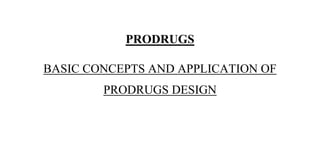This document discusses prodrugs, which are inactive chemical derivatives that are converted into active drugs within the body. It defines prodrugs and describes their objectives and ideal requirements. The document outlines different types of prodrugs including carrier-linked, bio-precursors, macromolecular, mutual, and bio-conjugates. It provides examples of common prodrug moieties and how prodrugs can address pharmaceutical problems like poor patient acceptability, gastric irritability, and low drug solubility. The document aims to provide basic concepts and applications of prodrug design.
















































































































